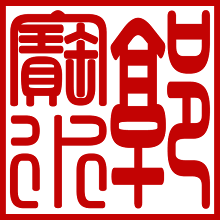(一)“有”
yg berarti “keberadaan” (“有” describe “presence”)“存在”的“有”
Both
“有” and “在” is describe
presence, but model of the structure is different. “有”is
describe the presence of people or thing location and time. Basic structure:
Location, time
words + 有 + nominal words
“有”
dan “在” sama2 mengartikan keberadaan, tapi bentuk
strukturnya berbeda. “有” mengartikan lokasi dan
waktu dari keberadaan orang atau benda. Struktur dasarnya:
Lokasi, waktu + 有 + kata bilangan
“有”和“在”都表示存在,可是他们的结构形式却不相同。“有”表示的是处所、时间存在着人或事物。基本结构是:
处所、时间词语 + 有 + 名词性词语
例如:(1)教室里有很多学生。
(2)唐代有位著名诗人,叫李白。
Nominal words in the front of “在”
is specific, nominal words in the behind of “有” more often is not
specific, therefore the structure of nominal words usually is using “quantity
name”.
Kata bilangan didepan “在”
adalah spesifik, kata bilangan dibelakang “有” umumnya tidak
spesifik, oleh karena itu struktur dari kata bilangannya sering menggunakan “nama
kuantitas”
“在”前的名词性词语一般是确指的,“有”后的名词性词语往往不是确指的,所以名词性词语前常常用“数量名”结构。
比较:词典在书架上。 --- 书架上有基本词典。
(确指)(specific) (不确指)(not
specific)
我在屋里。 --- 屋里有两个人。
(确指)(specific) (不确指)(not
specific)
(二)“有”
yg berarti memiliki (“有” describe possess) “领有”的“有”
As predicate, basic structure:
Noun (most
is life) + 有 + nominal words
Sebagai predikat, struktur dasarnya:
Kata benda
(biasanya makhluk hidup) + 有 + kata bilangan
作谓语时,基本结构是:
名词性词语(多是有生命的) + 有 + 名词性词语
例如:(1)人物都有两只手。
(2)他有很多朋友。
(3)他有一个漂亮的姐姐。
“有” can describe “have”
some kind of new condition that happen or appear. This time at behind of “有”
usually followed by “了” that describe change ;
usually the object of “有”is verb, sometimes noun. Basic
structure:
Noun + 有(了) + verb, noun
“有” bisa berarti “memiliki”
suatu keadaan baru yg terjadi dan muncul. Pada saat ini dibelakang “有”
umumnya diikuti oleh “了” yang berarti berubah ;
pada umumnya obyek dari “有” adalah kata kerja, juga
boleh kata benda. Struktur dasarnya:
Kata benda
+ 有(了) + kata kerja,
kata benda
“有”还可以表示“具有”某种新情况发生和出现。这时“有”后常常附有表示变化意义的“了”
;“有”的宾语常常是动词性词语,也有名词性的。基本结构是:
名词性词语 + 有(了) + 动词、名词
例如:(1)这几年,他的汉语有了明显的进步。
(2)他有女朋友了
(3)今年,教育又有了很大的发展。
If the front of “有”
have “又” as adverb, usually at behind of “有”
will add “了”.
Kalau didepan “有”
ada kata keterangan “又”,umumnya
di belakang “有” akan ditambah “了”.
“有”前有副词“又”时,“有”后一般都要加“了”
(1)他又有女朋友(X)
(2)我又有机会(X)
“有”后接“过”可以表示“曾经具有”的意义。
例如:(1)他有过去国外的机会,可是他放弃了。
(2)过去,她曾经有这种经历。
The common of “有”
will not receive modify from degree adverbs, but if the object is describe subject
attributed or do as abstract noun, “有” can receive the
modify from degree adverbs.
Bentuk umum dari “有”
tidak akan menerima perubahan dari tingkat kata keterangan, akan tetapi bila
obyeknya menunjuk pada sifat dari subyek atau kata benda abstrak, “有”
bisa menerima perubahan dari tingkat kata keterangan..
一般的“有”不受程度副词修饰,但是当宾语表示的是主语的属性,宾语多为抽象名词时,“有”可以接受程度副词的修饰。
例如:(1)这次社会实践很有意义。
(2)这个青年非常有头脑。
(3)小王很有领导才能。
(三)bentuk negative dari
“有” (negative model of “有”)
“有”的否定形式。
“有” only can use “没”
as negative, can`t use “不”. When the answer is deny
the question, can`t only use “没”. Shouldn`t have a specific
situation (refute, comparison, emphasize, etc) at the behind of the negative,
usually the front of object will not use not specific quantity words.
“有” hanya bisa
menggunakan “没” saat bentuknya negative, tidak boleh
menggunakan “不”. Saat menyangkal pertanyaan, tidak boleh
hanya menggunakan “没”. Tidak boleh ada keadaan
spesifik (sangkalan, perbandingan, penekanan, dll) dibelakang bentuk negative,
umumnya tidak akan menggunakan jumlah didepan obyek.
“有”只能接受“没”的否定,不能接受“不”的否定。对提问进行否定回答时,不能单独用“没”。否定后,不能在特定的场合下(反驳、对比、强调等),宾语前一般不用不确指的数量词语。
例如:(1)我没有时间,不能陪你去了。
(2)你有中国朋友吗? ---
没有。
(3)你有中国朋友吗? ---
没。(X)
(4)我没有自行车。
(5)我没有一两自行车。(X)
(四)bentuk pertanyaan
dari “有” (question model of “有“)“有”的疑问形式
Can add “吗” at the end of
sentences, also can use “有没有” model. But in addition of
the special situation (refute, comparison, emphasize, etc), if ask a question
using “有没有”, usually the front of object not use a
specific quantity.
Bisa menambahkan “吗”
di akhir kalimat, juga boleh menggunakan bentuk “有没有”. Akan tetapi selain
dalam kondisi khusus (sangkalan, perbandingan, penekanan, dll), jika bertanya
menggunakan “有没有”, pada umumnya didepan obyek tidak
menggunakan jumlah yg spesifik.
可以在句尾加“吗”,也可以用“有没有”的形式。但是用“有没有”提问时,除特殊场合外(反驳、对比、强调等),宾语前一半不用表示不确指意义的数量词语。
例如:(1)他到现在还没有住处吗?
(2)你有没有这三种书?(确指数量)
(3)今年夏天我们有假期没有?
(4)在美国,有很多中国饭店吗?
(5)在美国,有没有很多中国饭店?(不确指数量)
No comments:
Post a Comment
Just feel free to comment or ask anything my friend.
help us to improve this blog for the benefit of anyone who want to learn Chinese.
i`ll always try the best to answer or reply your comment as soon as possible ^.^